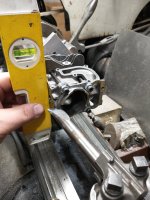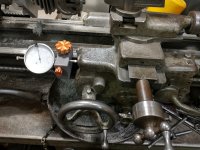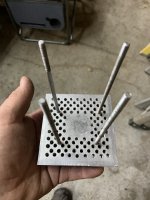You are using an out of date browser. It may not display this or other websites correctly.
You should upgrade or use an alternative browser.
You should upgrade or use an alternative browser.
Lathe pics and tricks.
- Thread starter Stump Shot
- Start date
Stump Shot
Active member
Probably wouldnt hurt to start with some minimum lathe requirement advice- like bed length minimums.
Perhaps 12 x 36 inch for a minimum? Better than hobby lathe chuck etc. Short bed lathes do not leave much room once a cylinder is bolted up to it.
Then the mounting plate, or ways of holding the cylinder securely and obviously a different set up for decking cylinders versus cutting squish bands.
Perhaps 12 x 36 inch for a minimum? Better than hobby lathe chuck etc. Short bed lathes do not leave much room once a cylinder is bolted up to it.
Then the mounting plate, or ways of holding the cylinder securely and obviously a different set up for decking cylinders versus cutting squish bands.
Norm
Member
I've always been amazed by those tools, and those who master themAlways an easier way to accomplish the same thing sometimes.
I'll start out with leveling the cylinder so a center mark or casting line can be used to center up the boring bar for those without a T post or setting up for the first time.
View attachment 1476
Stump Shot
Active member
Probably wouldnt hurt to start with some minimum lathe requirement advice- like bed length minimums.
Perhaps 12 x 36 inch for a minimum? Better than hobby lathe chuck etc. Short bed lathes do not leave much room once a cylinder is bolted up to it.
Then the mounting plate, or ways of holding the cylinder securely and obviously a different set up for decking cylinders versus cutting squish bands.
A 12 x 36 is a pretty good sized lathe and not wholly required to get the work done that we do. I for example am currently running a South Bend 9 model A lathe which is 9 x 24. I'm successfully(so far) able to cut every cylinder that I have come across, with ample length to spare and swing, the cross feed has been dicey at times with room to travel being really tight on some of the front feed cylinders.
I started as a hobbyist with an old Atlas bench lathe with about a 6 inch swing. It was not able to do quite everything and was soon replaced.
I believe @huskihl is running a modern style of bench lathe maybe he can report on his findings with it.
I'll try and post some pics later.
huskihl
Member
Mine is the common 9 x 19 size that are mostly made by the same company
Stump Shot
Active member
Here's pics of the mandrels and plates used by myself for turning cylinders on the lathe.
This is by no means the only way, just the way I found for myself and my equipment. One thing about machining, the tool you need most is the tool that you make.

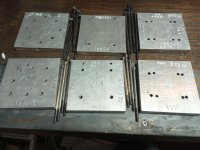 Mandrels are turned to different sizes on each end to pull double duty as well as patterns in the plates to work for multiple of different types of cylinders.
Mandrels are turned to different sizes on each end to pull double duty as well as patterns in the plates to work for multiple of different types of cylinders.
This is by no means the only way, just the way I found for myself and my equipment. One thing about machining, the tool you need most is the tool that you make.

 Mandrels are turned to different sizes on each end to pull double duty as well as patterns in the plates to work for multiple of different types of cylinders.
Mandrels are turned to different sizes on each end to pull double duty as well as patterns in the plates to work for multiple of different types of cylinders.huskihl
Member
scarr
Member
Got tired of trying to make out which holes were for which cylinders.
Ping chow, one size fits all
View attachment 1517
That would probable work out really well using a loose fit tap to get extra misalignment.
I use 1/4" all thread machined down and threaded to 5mm for most cylinders. With a few lengths of studs I you could do about any cylinder.
huskihl
Member
It works OK with the holes in the fins being larger. These are 10 MM apart with a 5MM offset. If I were to do it again, I would go 9 and 4.5 to give more options. I was worried about strength but it’s a non-issueThat would probable work out really well using a loose fit tap to get extra misalignment.
I use 1/4" all thread machined down and threaded to 5mm for most cylinders. With a few lengths of studs I you could do about any cylinder.
scarr
Member
It works OK with the holes in the fins being larger. These are 10 MM apart with a 5MM offset. If I were to do it again, I would go 9 and 4.5 to give more options. I was worried about strength but it’s a non-issue
I too have a uni-plate that I've drilled holes where needed to fit multiple cylinders. At first I marked the holes per the model of cylinder but I've since lost track. I always thought of a one plate fits all with slots but there are so many cylinders with non symmetric bolt patterns you'd need a lot of wiggle room. The swish cheese plate could be the answer!
Stump Shot
Active member
Reminds me of a sausage grinding plate, which, who knows might actually work if the right size and holes are available...Got tired of trying to make out which holes were for which cylinders.
Ping chow, one size fits all
View attachment 1517
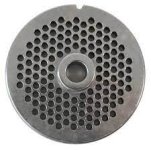
No sausage puns intended or implied.
Stump Shot
Active member
Interesting how everyone finds their own way with what they have available to them. I too tired of the guessing game and scribed each plate with the models that would fit. Some as much as 8 different models with one plate. I like the universal idea too as even my plates don't hit everything perfect though there is that wiggle room that allows a small bit of offset.
One thing I really like is the 5mm-8 Allen head cap screws I use which make adjustment a snap with just one wrench. I started with 100mm long ones and would just shim with oversize nuts for shorter cylinders. Now I have from 60mm up to 120mm in 10mm increments to take up pretty much everything.
One thing I did was helicoil all the holes so as not to strip if not all the way fully engaged into the plate, also got smarter(little) and make sure I use bolts that reach fully through, better to stick out the back then be short threaded. I can see where the threaded rod has it's advantage of being universal, but I like what I like and only have myself to satisfy.
Point being you're never wrong with what you build to machine with, even if it doesn't work it's called R&D to get you to make the thing that does work.
Idea sharing helps with this creativity and breads new ideas, like my sausage plate theory, just a funny or is it?...
One thing I really like is the 5mm-8 Allen head cap screws I use which make adjustment a snap with just one wrench. I started with 100mm long ones and would just shim with oversize nuts for shorter cylinders. Now I have from 60mm up to 120mm in 10mm increments to take up pretty much everything.
One thing I did was helicoil all the holes so as not to strip if not all the way fully engaged into the plate, also got smarter(little) and make sure I use bolts that reach fully through, better to stick out the back then be short threaded. I can see where the threaded rod has it's advantage of being universal, but I like what I like and only have myself to satisfy.
Point being you're never wrong with what you build to machine with, even if it doesn't work it's called R&D to get you to make the thing that does work.
Idea sharing helps with this creativity and breads new ideas, like my sausage plate theory, just a funny or is it?...


